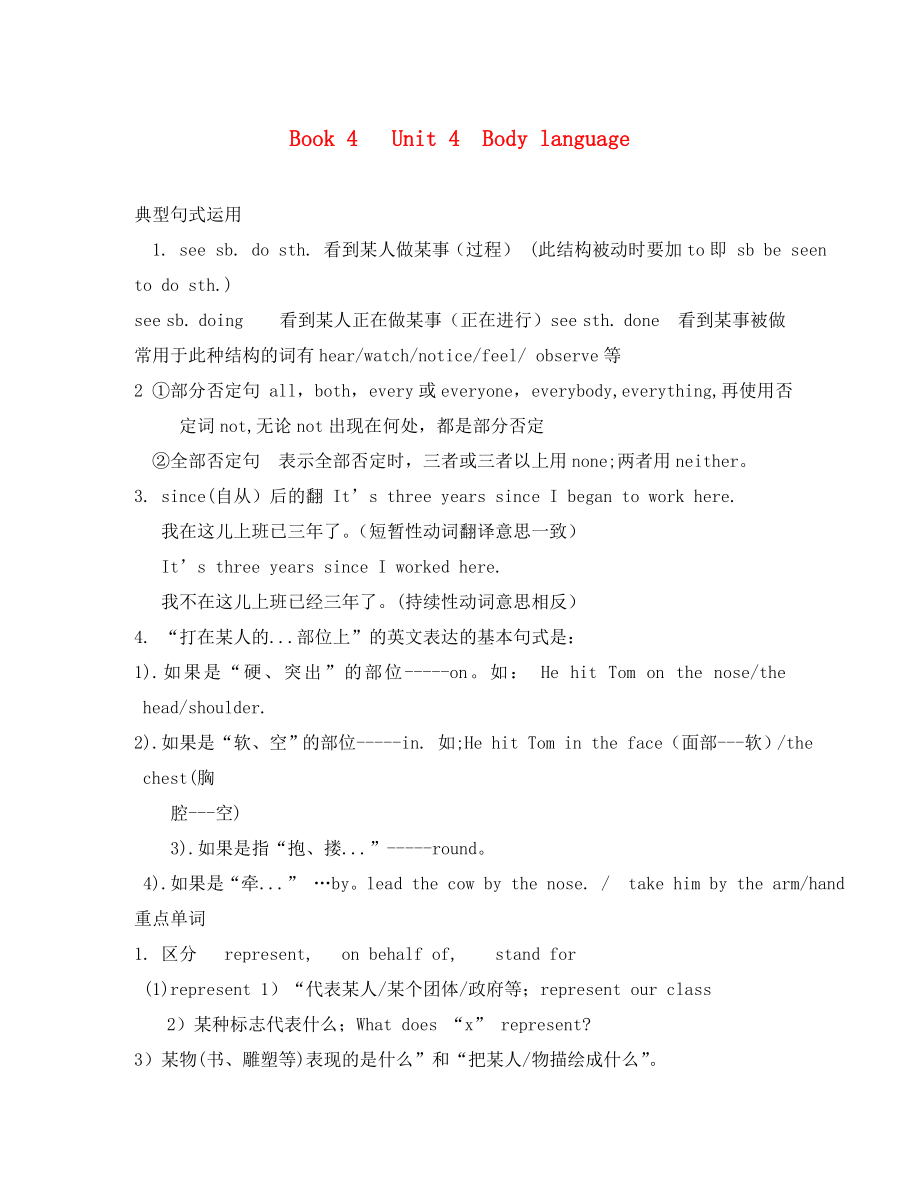《2020高中英語(yǔ) 短語(yǔ)知識(shí)點(diǎn) Unit 4 Body language學(xué)案 新人教版必修4》由會(huì)員分享�,可在線閱讀,更多相關(guān)《2020高中英語(yǔ) 短語(yǔ)知識(shí)點(diǎn) Unit 4 Body language學(xué)案 新人教版必修4(3頁(yè)珍藏版)》請(qǐng)?jiān)谘b配圖網(wǎng)上搜索���。
1���、Book 4 Unit 4 Body language
典型句式運(yùn)用
1. see sb. do sth. 看到某人做某事(過(guò)程) (此結(jié)構(gòu)被動(dòng)時(shí)要加to即 sb be seen to do sth.)
see sb. doing 看到某人正在做某事(正在進(jìn)行)see sth. done 看到某事被做
常用于此種結(jié)構(gòu)的詞有hear/watch/notice/feel/ observe等
2 ①部分否定句 all��,both����,every或everyone�����,everybody,everything,再使用否定詞not,無(wú)論not出現(xiàn)在何處�,都是部分否定
②全部否定句 表示
2��、全部否定時(shí)����,三者或三者以上用none;兩者用neither。
3. since(自從)后的翻 It’s three years since I began to work here.
我在這兒上班已三年了�����。(短暫性動(dòng)詞翻譯意思一致)
It’s three years since I worked here.
我不在這兒上班已經(jīng)三年了��。(持續(xù)性動(dòng)詞意思相反)
4. “打在某人的...部位上”的英文表達(dá)的基本句式是:
1).如果是“硬�����、突出”的部位-----on�����。如: He hit Tom on the nose/the head/shoulder.
2).如果是“軟�����、空”的部位
3��、-----in. 如;He hit Tom in the face(面部---軟)/the chest(胸
腔---空)
3).如果是指“抱��、摟...”-----round�����。
4).如果是“牽...” …by。lead the cow by the nose. / take him by the arm/hand
重點(diǎn)單詞
1. 區(qū)分 represent, on behalf of, stand for
(1)represent 1)“代表某人/某個(gè)團(tuán)體/政府等�����;represent our class
2)某種標(biāo)志代表什么�����;What does “x” repre
4���、sent?
3)某物(書(shū)、雕塑等)表現(xiàn)的是什么”和“把某人/物描繪成什么”��。
The picture represents a hunting scene. The king was represented as a nice figure in the movie
(2)on behalf of表示“代表/代替某人”�。
On behalf of everyone here, I wish you a very happy holiday.我代表在座各位祝你假期愉快。
(3)stand for 表示字母���、數(shù)字、符號(hào)等“代表/象征什么”���。
2.區(qū)分 likely, possible,
5����、 probable
1) possible/probable 前不能用人做主語(yǔ)���,而likely人和物均可
It is likely that...或sb./sth.is likely to do.�。
對(duì)比:可用 It’s possible/probable that… 但不能用 He is possible/probable to succeed.
2) 可能性 probable, likely較大�����,possible較小��,
3.curious adj.好奇的�����;奇怪的
(1)be curious about...對(duì)……感到好奇 be curious to do 極想做某事
6�����、
(2) out of curiosity 出于好奇 meet/satisfy one’s curiosity 滿足某人的好奇心
with curiosity=curiously 好奇地
4.易混辨異 approach, way, means, method
approach:n.接近, 入門 ;方法,途徑 way�;方式,方法
means�;手段��,途徑 method 系統(tǒng)的�,有條理的方法(teaching method)
主要通過(guò)介詞區(qū)分
(1)表示“做……的方法”時(shí)與介詞搭
the approach to doing sth (注意:只有approa
7、ch 接介詞to)
the way of doing sth. (也可 the way to do/of doing)
the means of doing sth the method of doing sth
(2)表示用什么方法時(shí)與不同的介詞搭配:
with this method in this way by this means
5.agree on/upon sth.雙方就某事達(dá)成協(xié)議
agree to do sth.同意做某事 agree to sth. 同意某事
agree with sb./ what sb. said 同意某人意見(jiàn)
a
8�、gree with 與……一致;(氣候���、食物等)適合……
6. at ease:舒適��,自在 ill at ease: 感到不自在���,不舒服
feel at ease 感到心情放松 put/set sb. at ease 使某人放松 with ease 容易地����,毫不費(fèi)力地
7.be wrong/mistaken about 誤解�����,弄錯(cuò)
go wrong出差錯(cuò)��;犯錯(cuò)誤 do sb. wrong /do wrong to sb.冤枉某人
8. be associated with: 與…有聯(lián)系association: 聯(lián)系����,社團(tuán)�,聯(lián)想
9.* connecting flights:轉(zhuǎn)接班機(jī)
10. respectful : 表示尊敬的(尊敬的對(duì)象在后)
respectable: 值得尊敬的(尊敬的對(duì)象在前)��;
相當(dāng)?shù)模捎^的 a respectable income
respective: 各自的���,分別的 with respect to;關(guān)于����,至于
11. nod at sb. 朝某人點(diǎn)頭 12. in the light of: 鑒于, 由于, 按照
 2020高中英語(yǔ) 短語(yǔ)知識(shí)點(diǎn) Unit 4 Body language學(xué)案 新人教版必修4
2020高中英語(yǔ) 短語(yǔ)知識(shí)點(diǎn) Unit 4 Body language學(xué)案 新人教版必修4

